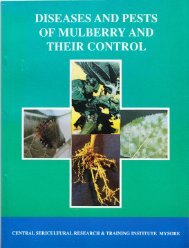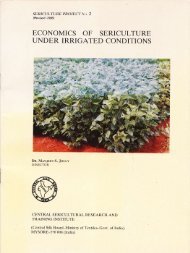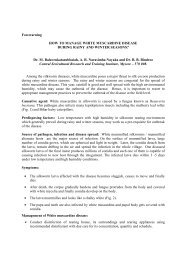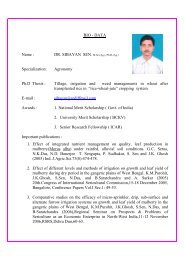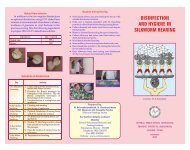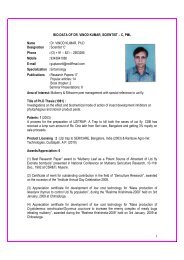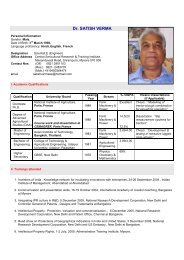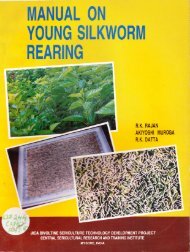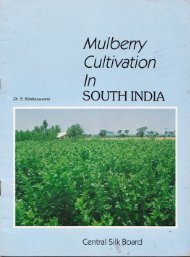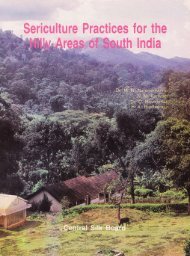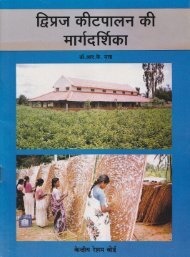E}A]\GALORE
Improved Method Rearing Younf Age (Young) Silkworms - Central ...
Improved Method Rearing Younf Age (Young) Silkworms - Central ...
- No tags were found...
You also want an ePaper? Increase the reach of your titles
YUMPU automatically turns print PDFs into web optimized ePapers that Google loves.
leeding the chawki stages dry rather quickly, if left exposed. Therefore, the chopped<br />
leavejshould be collected in plastic or metallic basins or buckets and should be kept<br />
covered, Proper preservation of chopped leaves is also highly essential and every care<br />
should be paid to this important aspect.<br />
During the rainy seasons, however, the leaves are replete with excessive<br />
moisture. Similarly, the atmospheric humidity is also comparatively higher, and<br />
therefore, the drying of leaves due to exposure does not present much of a problem<br />
of preservation. Hence, the special care required to preserve the freshness of leaves<br />
during normal seasons or Summer season may not be found necessary' On the other<br />
hand, if the teaves are wet with droplets of rain water physically present on the surface<br />
of leaves, they may have to be spread out in thin layers, so that the excess moisture<br />
present on the surface may evaporate away'<br />
F. Ecological Requirements of Environment:<br />
It has been scientifically established that early instars of silkworms show<br />
best growth under ideal condittons of temperature around 27"c and rglative<br />
humidity around 90 per cent. Therefore, in order to procure best growth and<br />
consequently a robust batch of young age worms, rearings should be conducted in<br />
environmental conditions as close as possible to the above ideal' By environment, the<br />
immediate vicinity of the worms is meant, i.e., the rearing bed envtronment' The<br />
,requirements of environment can be achieved to a large extent by resorting to young<br />
age worm rearing in suitable container trays. Wooden trays measuring 3'x 2' and 3"<br />
in height are suitable for the purpose.<br />
The required humidity is secured by rearing the young age worms in between<br />
paraffin papers which are used as base for the rearing bed at the bottom of the tray<br />
and as a cover over the rearing bed. When the atmospheric humidity fall low, say below<br />
70 per cent, wet paper or wet foam rubber bands should be placed around the rearing<br />
bed in between paraffin papers to increase the humidity of the rearing bed. As a further<br />
precaution to maintain optimum humidity and temperature, the rearing trays are piled<br />
one over the other upto a convenient height (10 to 15 trays) as shown in Figure 3'<br />
The top-most tray should be a dummy trav without the worms.<br />
During rainy seasons, however, the atmospheric humidity will be high and so<br />
also the moisture content in the leaves. Therefore, quick withering of leaf is not<br />
experienced. On the other hand, these factors will tend to increase the bed humidity<br />
beyond 90 per cent. Under such circumstance, it will not be necessary to use paraffin<br />
p"p"r at the bottom of the rearing bed or the wet paper or wet foam rubber bands<br />
beiween the paraffin papers. Should the humidity be close to 100 per cent (as during<br />
days of continuous rain), the piling of the trays one over the other may also be<br />
dispensed with. lt may be found even desirable to delay the covering of the rearing<br />
bed with paraffin paper for some time (about 15 tO 30 minutes) after feeding, so that<br />
some of the excessive moisture present in the leaf could evaporate'<br />
10


![E}A]\GALORE](https://img.yumpu.com/54052619/14/500x640/eagalore.jpg)

